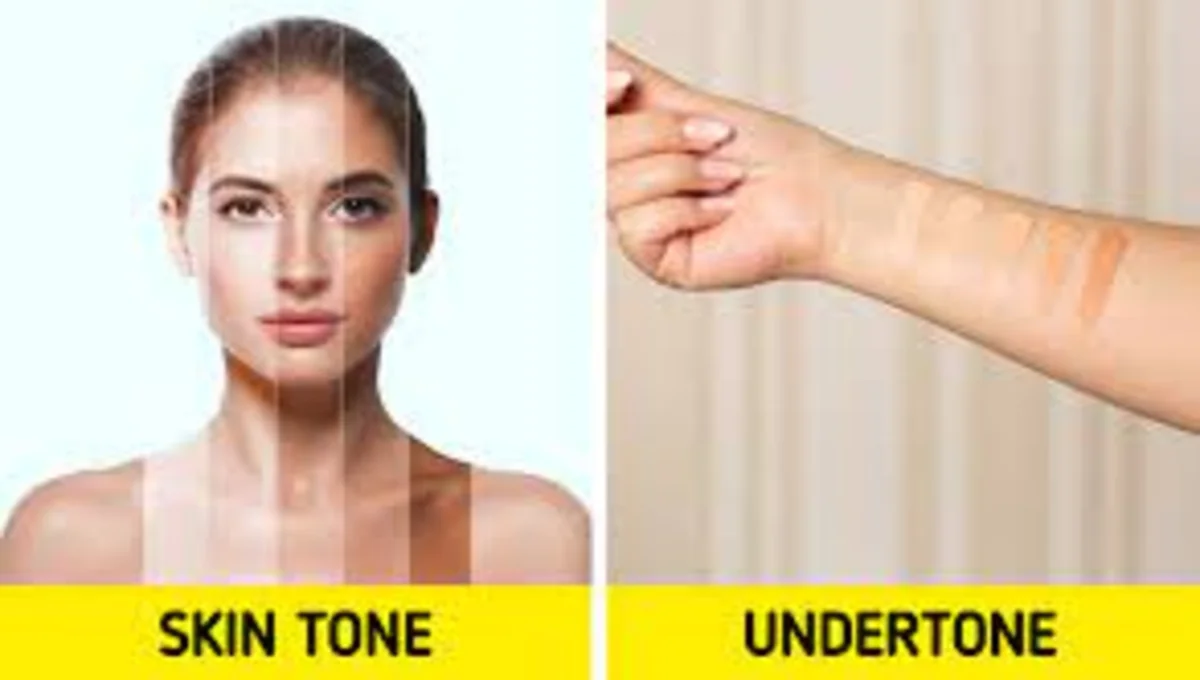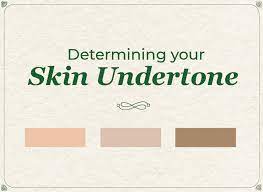How to Determine Your Skin Tone and Undertone

In the world of skincare and beauty, Determine your skin tone and undertone is the foundational step to unlocking your true radiance. It’s the key that unlocks the doors to a world of cosmetics tailored to enhance your natural beauty. If you’ve ever wondered why a particular shade of lipstick or foundation looks amazing on someone else but not quite right on you, the answer lies in your skin tone and undertone.
What Are Skin Tone and Undertone?
Skin tone is Skin’s surface color. It’s what you see when you look at your face in the mirror or examine your arms. Skin tones can range from very fair to deep ebony and everything in between. It’s an essential factor in choosing the right foundation, concealer, and blush to complement your skin.
Undertone: Undertone, on the other hand, is the subtle hue that lies beneath the surface of your skin. It’s not always visible to the naked eye, but it plays a pivotal role in determining which makeup colors, clothing, and jewelry shades enhance your natural beauty. Undertones has divided in three main categories: warm, neutral and cool.
Now that you have a basic understanding, let’s dive into the methods to determine your skin tone and undertone effectively.
Identifying Your Skin Tone

Determining your skin tone is the first step in the journey to flawless beauty. Here are the primary methods to help you identify your skin tone:
1. The Vein Test
One of the simplest ways to determine your skin tone is by examining the veins on your wrist. Here’s how it works:
– See at the veins on your wrist in sun light. Are they more on the blue or green side?
– If appear bluish, you will likely have a cool skin tone.
– If they appear greenish, your skin tone is warm.
– If you can’t decisively say they’re either blue or green, you might have a neutral skin tone.
2. The Jewelry Test
The type of jewelry that complements your skin can be a strong indicator of your skin tone:
– Do you look better in gold jewelry or silve rjewelry?
– Gold jewelry tends to flatter warm skin tones.
– Silver jewelry is more flattering on cool skin tones.
3. The White Paper Test
A simple white piece of paper can also reveal your skin tone:
– Hold a white paper piece to your face.
– Does your skin appear more yellowish or rosy next to the paper?
– Yellowish suggests a warm skin tone, while a rosy appearance indicates a cool skin tone.
4. The Clothing Test
Examine your preferences in clothing colors:
– Are earthy tones like red, orange, and olive your go-to colors?
– If so, you likely have a warm skin tone.
– Do you find yourself gravitating towards blues, pinks, and purples?
– This could be a sign of a cool skin tone.
5. The Sun Reaction Test
How your skin reacts to the sun’s rays can provide valuable insights:
– Do you tan easily and rarely burn?
– This indicates a warm skin tone.
– Do you burn easily and have difficulty tanning?
– You are likely to have a cool skin tone.
– If your reaction is somewhere in between, you may have a neutral skin tone.
Determining Your Undertone

Identifying your undertone is equally important, as it influences the colors that best complement your complexion and enhance your beauty. Here’s how to determine your undertone:
1. The Jewelry Test (Part 2)
We mentioned the jewelry test earlier in the context of skin tone. It’s just as useful for pinpointing your undertone:
– If gold jewelry enhances your features, you likely have a warm undertone.
– If silver jewelry complements your skin, your undertone is cool.
2. The Color of Your Veins
Now, let’s look at your veins once more, but this time, we’re interested in the undertone they suggest:
– If your veins appear bluish, you have a cool undertone.
– Greenish veins typically point to a warm undertone.
– Neutral undertones might have difficulty determining the exact color of their veins in this test.
3. The Sun Reaction Test (Part 2)
Your skin’s reaction to the sun can provide clues about your undertone as well:
– If you tan easily and your skin takes on a golden hue, your undertone is likely warm.
– If you tan but remain on the fair side and have pinkish undertones, you have a cool undertone.
– For those who don’t tan much and have a neutral reaction to the sun, a neutral undertone is probable.
Skin Tone and Undertone in Skincare
Understanding your skin tone and undertone is not just about cosmetics; it also plays a significant role in your skincare routine. Here’s how to leverage this knowledge for healthier and more radiant skin:
1. Choosing the Right Skincare Products
Your skin tone and undertone influence how your skin reacts to different products. For example:
– If you have a cool undertone, you may be more prone to redness. Opt for soothing, anti-inflammatory skincare products.
– If you have a warm undertone, your skin might be more susceptible to pigmentation. Look for products that help even out skin tone.
– Neutral undertones should focus on maintaining a balanced skincare routine that addresses their unique needs.
2. Sunscreen Selection
Skin tone and undertone affect your skin’s susceptibility to sun damage. It’s essential to choose the right sunscreen to protect your skin:
– Fair skin tones are generally more prone to sunburn, so a higher SPF is recommended.
– Deeper skin tones have more natural protection but should still use sunscreen to prevent hyperpigmentation.
3. Skin Sensitivity
Understanding your skin’s natural tendencies can help you avoid irritation and sensitivity:
– Cool undertones may have more sensitive skin that’s prone to redness and irritation.
– Warm undertones might experience more oiliness and pigmentation issues.
– Neutral undertones should focus on a balanced skincare routine that prevents any particular issue from becoming severe.
Makeup that Enhances Your Skin Tone
With your skin tone and undertone identified, you can now confidently select makeup products that will enhance your natural beauty. Let’s explore the best makeup choices for each category:
1. Makeup for Cool Skin Tones
Cool undertones look stunning in makeup that complements their rosy complexion. Here are some recommendations:
– Foundation: Look for shades with a cool or pink undertone.
– Lipstick: Opt for blue-based reds, pinks, and berry shades.
– Eyeshadow: Cool-toned colors like purples, blues, and silvers are excellent choices.
2. Makeup for Warm Skin Tones
Warm undertones glow with makeup in earthy and golden tones. Here are some makeup suggestions:
– Foundation: Choose shades with a warm or yellow undertone.
– Lipstick: Warm reds, corals, and orange hues will flatter your complexion.
– Eyeshadow: Earthy tones like browns, oranges, and golds are ideal for warm skin tones.
3. Makeup for Neutral Skin Tones
Neutral undertones have the versatility to pull off a wide range of makeup colors. Here are some recommendations:
– Foundation: Go for shades with a balanced undertone, not too warm or cool.
– Lipstick: Neutral undertones can experiment with various shades, but rose-toned colors often work well.
– Eyeshadow: You have the freedom to explore both cool and warm eyeshadow shades.
Product Recommendations and Reviews
Here’s a table featuring some well-loved products from reputable brands designed to enhance your natural beauty based on your skin tone and undertone. We’ve also included reviews from users who have experienced the magic of these products firsthand.
| Product Name | Brand | Suitable Skin Tone | User Reviews |
| Radiant Glow Primer | BeautyLuxe | All Skin Tones | “This primer gives my skin a luminous boost. It’s perfect for my neutral undertone.” – Sarah |
| Perfecting Foundation | FlawlessFinish | Cool and Warm | “I’m a cool undertone, and this foundation blends seamlessly, leaving my skin flawless.” – Mark |
| Sunset Kiss Lipstick | GlamourCosmetics | Warm | “The warm undertone of this lipstick adds a touch of radiance to my complexion.” – Emily |
| Dreamy Eyeshadow Palette | ArtistryAesthetics | Neutral | “I love the versatility of this palette. It’s perfect for my neutral undertone.” – Lisa |
Frequently Asked Questions
Now, let’s address some common questions that often arise when discussing skin tone and undertone.
1. Can my skin tone change over time?
Your skin tone can vary due to factors like sun exposure and aging. However, your undertone remains relatively stable throughout your life.
2. Can I have a cool skin tone and a warm undertone?
Yes, it’s entirely possible. In such cases, your skin may appear warm, but the undertones will influence the shades that enhance your natural beauty.
3. How can I determine my undertone if I’m still uncertain after trying the tests?
If you’re unsure about your undertone, consult with a professional makeup artist or skincare expert.
4. Can I wear makeup that doesn’t match my undertone?
Absolutely! Makeup is the form of self expression. While certain shades may enhance your natural beauty, feel free to experiment with colors that make you feel confident and beautiful.
5. Do I need to consider my skin tone and undertone when choosing hair colors?
Yes, understanding your skin tone and undertone can guide you in selecting hair colors that complement your overall look. It’s particularly helpful when deciding on hair dye shades.
Conclusion
Determining your skin tone and undertone is the cornerstone of a successful beauty journey. With this knowledge, you can confidently select skincare products like face serum and makeup shades that enhance your natural beauty. Remember, beauty is not about adhering to strict rules; it’s about feeling confident and expressing yourself.
So, go ahead and embrace your unique skin tone and undertone, and let your inner beauty shine through. Whether you have a cool, warm, or neutral undertone, your beauty is something to celebrate and cherish. Discover the power of understanding your skin, and watch as your confidence and radiance soar to new heights.






